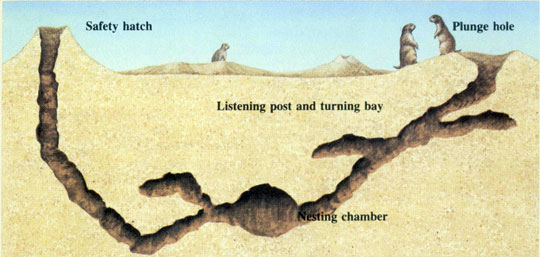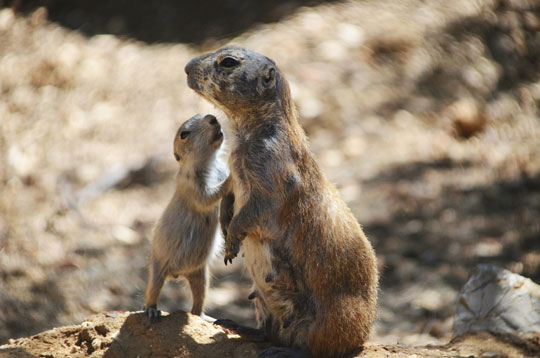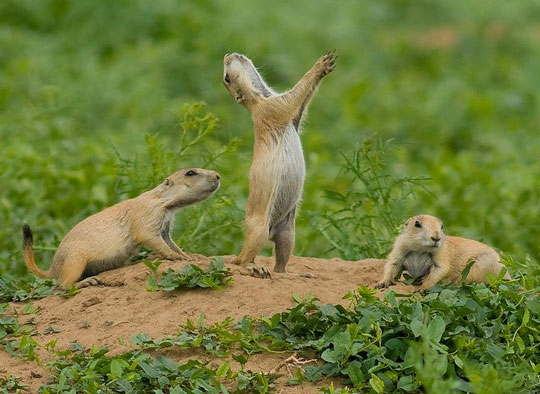|
Like many of my novels, the upcoming Hostile Emergence features a number of strange creatures, some friendly, some not so friendly. Also, sometimes you think they may be friendly, but then they surprise you. In Hostile Emergence, Skyra, Lincoln, and their team encounter a vast colony of prairie dogs (called a prairie dog town). In honor of the new book's release, today's Awesome Animal is the prairie dog! What the heck is a Prairie Dog? First of all, prairie dogs are rodents, in a group referred to as ground squirrels. The five species of prairie dogs are all found in North America, especially in the Great Plains. The name prairie dog comes from the fact that they tend to live on prairies, and their alarm call often sounds like the barking of a dog (although a very small, squeaky dog). Prairie dogs average about 15 inches (38 cm) long, with an average weight of about 2 pounds (.9 kg). Most people would describe prairie dogs as "cute," except maybe landowners who do not like all the burrows and mounds. Amazing Facts about Prairie Dogs Prairie dogs are what we call a keystone species. This means they are a type of animal in a particular ecosystem that many other animals rely on. If a keystone species is removed from an ecosystem, this will drastically change the balance of life there. Scientists estimate that about 150 other species depend on prairie dogs for their survival. For starters, many predators feed on prairie dogs. A few examples: hawks, badgers, coyotes, bobcats, weasels, foxes, eagles, and black-footed ferrets. In fact, black-footed ferrets feed almost entirely on prairie dogs, and these ferrets are almost extinct due the extreme loss of prairie dog colonies resulting from habitat destruction (the prairie dog's historical range has shrunk by more than 95%). So many animals feed on prairie dogs that Kristy Bly of the World Wildlife Foundation called prairie dogs the "Chicken McNuggets of the grasslands." Getting munched on is not the only reason prairie dogs are a keystone species. They live in vast colonies, and their activities improve the quality of the soil (their tunnels aerate it and their droppings fertilize it). Check out this video on prairie dog towns. Prairie dog towns can be huge. Many of the largest prairie dog colonies are now a thing of the past due to urban and suburban development. However, prairie dogs were once considered the most abundant mammals in North America. Some prairie dog towns are relatively small, perhaps only a few acres. In Kansas, though, there is one that still exists today that is over 100 miles (160 km) long! Prairie dogs are very social animals. They live in family groups called coteries. Well, actually, the families are called coteries in two species of prairie dogs (black-tailed and Mexican prairie dogs), but family groups are called clans in the other three species (white-tailed, Gunnison’s, and Utah prairie dogs). If you're wondering why the different names for family groups, coteries tend to be more tightly-knit groups than clans. There are certain behaviors (kissing and grooming) prairie dogs do only with members of their own coterie and not with members of other coteries. A coterie (or clan) is the group that lives within a single burrow. Multiple coteries are grouped together to make a neighborhood, and multiple neighborhoods make up a prairie dog town (a colony). Each coterie will have a few breeding males, a larger number of breeding females, and however many young they are raising at any given time. Females stay within their coterie for their entire lives, while males leave the groups when they become mature to find another group to breed in (this avoids excessive inbreeding). Below is a typical burrow for a prairie dog coterie. Remember we talked about 150 other animals that rely on prairie dogs? Many animals make prairie dog burrows their homes. Examples include rabbits, rattlesnakes, salamanders, spadefoot toads, camel spiders, countless insects, and other animals that can’t dig burrows on their own. Many of these occupy the burrows even when prairie dogs live there, and others, such as the burrowing owl, live in abandoned burrows. If you blink, you might miss the prairie dog mating season. We tend to think that prairie dogs are prolific breeders. Not really true. Female prairie dogs only mate one time per year, in early winter. When it's time, they go into estrus for only one hour. That's not a typo—one hour! If mating is successful, they will have a litter of three to eight pups. On average, only half of those pups will survive their first year. Here's an interesting tidbit: Once a male has mated with a female, he will not mate with her again during her brief estrus. However, he will prevent other males from mating with her by inserting what's called a mating plug (also called a copulation plug). Yep, this is a real thing. Many animals have these. It's a gelatinous secretion the male deposits in the female, and it solidifies to prevent other males from having access. Weird, huh? Once the young are born, the adult females care for the young, while the males defend the burrow (they may look cute, but prairie dogs can be vicious fighters). We definitely need to talk about prairie dog communication. Prairie dogs do a lot of yipping. Yip-yip-yip-yip. To us mere humans, all these yips may sound similar, but prairie dogs have an astounding array of communication signals, especially related to predator warnings (everything wants to eat prairie dogs, remember?). Scientists have found that prairie dogs can not only signal that a predator is approaching, they can also put together strings of sounds that communicate the predator species, size, color, speed, and direction. I know... this seems hard to believe, but extensive behavior studies have shown it to be true. For example, prairie dogs can alert each other that there’s not just a human approaching, but a tall human wearing the color blue. Amazing! This should give you an idea of how complex these calls can be: When a prairie dog signals that a hawk is approaching, all the prairie dogs that are directly in the path of the approaching hawk will dive into their holes, while all those outside of the hawk's path will stand on their hind legs and watch. Prairie dogs also have specific calls when they see an animal they know is not a predator. Prairie dogs even have a call to signal that a predator is gone. The call is a jump-yip, in which the caller arches its back so suddenly that it jumps off the ground, then this is followed by a shrill yip. See below. Finally, you may have seen photos of prairie dogs kissing. This seemingly romantic behavior is actually how they confirm that another prairie dog is part of their family group. Regardless, you have to admit there is something endearing about it, right? So, the Prairie Dog deserves a place in the S.A.H.O.F. (Staggering Animal Hall of Fame). FUN FACT: The term staggering was first used in the mid 1400s. As I'm sure you can guess, it came from the word stagger, which means to "walk unsteadily." Stagger actually comes from stakeren, a Scandinavian word meaning "to push, shove, cause to reel." And that word may have had an original literal meaning of "to hit with a stick." Anyway, in the mid 1400s, people came up with staggering, an adjective to describe something so amazing or overwhelming that it makes you stagger. It still means pretty much the same thing today. So, staggering is another way to say awesome! Photo Credits:
Alligator and manatee - Patrick M. Rose/SAVE THE MANATEE CLUB via Wired Sloth - UW-Madison/Zach Peery via Phys.org Bat with baby - San Diego Zoo Prairie dog #1 - Deposit Photos stock images Prairie Dog Town - Texas Coop Power Prairie dog burrow - Devil's Tower Handbook Prairie dog with young - Deposit Photos stock images Prairie dog jump-yip - Wikimedia Commons Prairie dogs kissing - KXCI
0 Comments
Leave a Reply. |
Stan's Cogitations
Everyone needs a creative outlet. That's why I write. Archives
July 2024
|







 RSS Feed
RSS Feed